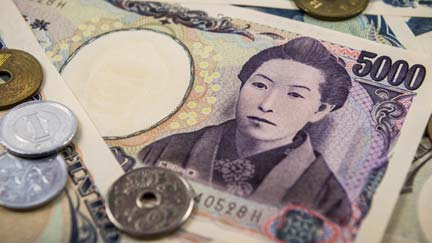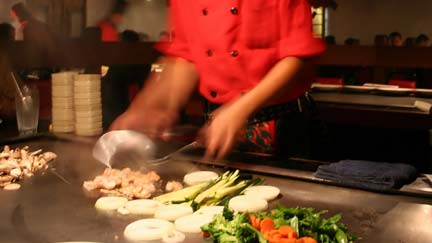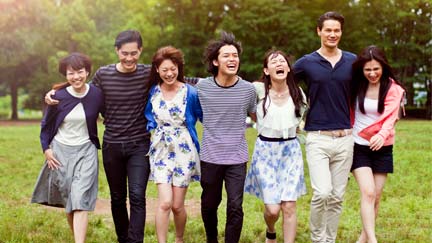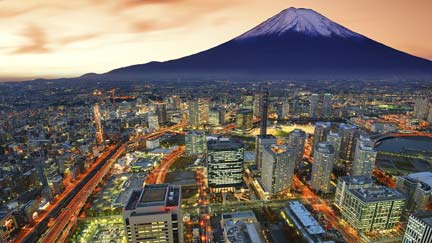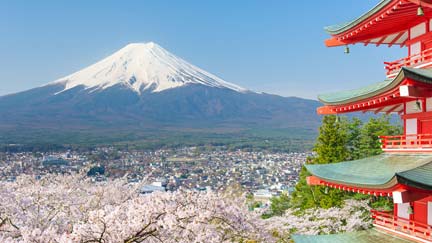Japan Travel Guide
“Have you ever had that feeling — that you’d like to go to a whole different place and become a whole different self?” – Haruki Murakami
-
Before You Go -
Tourism -
Places to Visit -
Cities to See -
Blog -
Packing Tips -
Helpful Links
Japan is a land of duality, a place that balances tradition with the cutting edge. The bright neon glow of the city signs as you stand next to a 100-year-old shinto shrine. The rolling green farmland whipping by the window as you kick back in a train. When you travel to Japan, you notice that the scales of new and old seem to be constantly balancing each other; the future and past existing next to each other in a beautiful harmony.

For a student traveler there, the constant ability to choose new or traditional becomes an exercise in balance. You can stay in a buddhist monastery, and experience the serene natural beauty of Mt. Koya. You can also stay in a capsule hotel, and experience the lights and sounds of gigantic, six-story arcades. Use our Japan Travel Guide to help you get the most out of this incredible country.
Get Email Travel Deals
Sign up for our emails to receive travel deals, news, contests and special offers.
(You can opt out at any time.)
5 Things to Know Before You Visit Japan
Language
Japanese may seem like a daunting language, but don’t freak out; a ton of the signs in Japan are in English or Romaji, which is Japanese words spelled using the English alphabet. A few key phrases couldn’t hurt to learn, and most Japanese people are happy to help a tongue-tied student traveler. If someone is shy when you speak to them, don’t worry; they’re a little disappointed that they can’t help as much as they would like, and might run away to try and find someone who can.
Currency & Tipping
The currency of Japan is yen ( ¥ ), and it’s pretty easy to translate over to the U.S. dollar in your head; 1 yen roughly equals 1 cent (So ¥100 is $1.00, get it?). As advanced as Japan is technologically, there are a lot of “cash only” retail spots, so carry cash with you. Make sure your bank will let you withdraw cash from an ATM in Japan; this will save you from going to a money exchange. Also, tipping is considered rude in Japan, so don’t leave cash for your server.
Japanese Cuisine
Japan is a wild adventure in eating. You can find ramen places with vending machine ordering systems, where the machine will print a card that you hand to the chef. There are sushi restaurants that will send food by on a conveyor belt; take whatever looks good and they’ll tally up your bill based on how many plates you have. You’ll spot a vendor selling takoyaki, which is delicious octopus in balls of fried dough. You’ll go back to college with a list of new favorite foods.
Tech Tips
It’s kinda tough to keep your cellphone working when you hop over to Japan, or at least it is to do so cheaply. There are some free apps, like “Travel Japan Wi-Fi,” that will get you connected so you can use maps and translation apps, two big helps when you’re lost and don’t know the language. There are other options, like renting a Wi-Fi hotspot device, but you can get a lot done by just using the free Wi-Fi in convenience stores, coffee shops, and some train stations.
Cultural Differences
There are a few cultural differences in Japan, but nothing too serious. Homes and hostels often have you remove your shoes and put on slippers they provide. Garbage cans are rare, and littering is a big no-no, so you might end up with a food wrapper in your pocket. You might read about complicated etiquette stuff in Japan, but don’t sweat it; just act polite and nice, and any sort of misstep you make will be chalked up to you being a foreign student and forgiven.
Tourism in Japan
When is the best time to visit Japan?
For a trip to Japan, late spring and late autumn are magical. The late spring, from March to May, is when the legendary cherry blossoms are in full effect, the temperature is mild, and the rains are less frequent. This is also the craziest tourist time in Japan, so plan accordingly. From September to November the weather is similarly nice, but with a little more rainfall, and the leaves are changing for Autumn. Summers in Japan are muggy and hot, and their winters are chilly but it rarely drops below freezing, except for mountainous areas. The bonus about traveling to Japan during their winter? The crowds will be smaller and the flights to Japan are cheaper.
Is it safe to travel to Japan?
The violent crime in the Land of the Rising Sun is very low, so when you visit Japan, have no fear. The country has a reputation for being one of the safest in the world for tourists, ranked in the top 10 on the Global Peace Index. However, it’s always a good idea to keep your wits about you in a new place, and make smart choices. Credit card fraud has been increasing, so think twice before swiping your card at a shady-looking ATM. Like at any bar or nightclub, you should be aware of your surroundings and always keep a clear head. Infrequently, natural disasters like earthquakes and tsunamis can happen, but the chances of you being in the wrong place at the wrong time are low. Just to be covered, remember a few important phone numbers:
- Ambulance and Fire: Dial 119
- Police: Dial 110
- Embassy of the United States, Tokyo: 03–3224–5000
Places to Visit in Japan
It’s hard to choose just a handful of cool places to go in Japan, but here’s our best attempt. There are a thousand things to do in Tokyo, from cat cafes to night clubs, and everything in between. Outside the metropolis of Tokyo, there is scenic beauty to behold and unique, smaller cities that have a style all their own.
Golden Gai
Golden Gai is a maze of tiny, seven-seat bars in the Shinjuku neighborhood of Tokyo. Here you literally rub elbows with ex-pats and locals, and it’s hard not to make friends with the people you’re sitting next to.
Mt. Fuji
Pack some boots, because Mt. Fuji is worth it. Incredible to look at, and incredible to visit, this symbol of Japan is just a train ride out of Tokyo. It’s a great day trip to get you out of the city and back to nature.
Mt. Koya
On Mt. Koya, you can stay with monks, who will treat you like an honored guest. Walk around the ancient graveyard that dominates the top of the mountain with shrines and a temple, and eat some vegetarian monk fare.
Dōtonbori in Osaka
A canal-centric neighborhood in Osaka famous for it’s bright neon signs, Dōtonbori is a great place to eat, shop, or simply take in the electric show of the famous Glico sign, seen as a symbol of Osaka.
Taito Station
If you’re in Akihabara, Tokyo, and want to play some video games, just look for the big building marked with the Space Invader. Inside Tatio station, you’ll be bombarded with the sights and sounds of five whole floors of gaming madness.
Nara's Bowing Deer
Nara, once the capital of Japan, is now home to Nara Park. Here, the deer there have become so accustomed to people they’ll ask for a “deer-cracker” by bowing to you. Bow back, give the deer a snack, and pet them on the head.
Cities to See in Japan
There are so many places for students to visit in Japan; it’s a lot of country packed onto a relatively small island. Thankfully, it’s easy to use trains to hop from place to place and city to city, and you’re going to want to do just that. The cities of Japan are big, vibrant, and full of things to do, each one offering a unique charm that sets it apart from the others.
Tokyo
Tokyo is the de-facto base for a lot of travelers in Japan, and for good reason. It’s huge, and has a little bit of everything within it’s city limits. The subway system is extensive, and the city is broken up into 23 wards that are cities unto themselves, almost like the boroughs of New York City. You could spend an entire trip exploring Tokyo and never see everything, even with ourtravel tips
Osaka
Osaka is second in size and scope only to Tokyo, but somehow it feels more personal and welcoming. Visit Amerika-mura and see the miniature replica of the Statue of Liberty that overlooks the fashion shops of Triangle Park, or head to the electric glow of Dōtonbori for food and fun.
Kyoto
Kyoto is thought of as the cultural heart of Japan, and is packed with museums, historical buildings, temples, castles and shrines. The world-famous Temple of the Golden Pavilion is found here, along with lush gardens like the one at Shugaku-in Imperial Villa. It’s also the home of Japan’s “Hollywood,” and you can take a walk on the set of an old samurai flick.
Hiroshima
Hiroshima means “Broad Island” in Japanese, and is also known as the “City of Peace” after the bombing during World War Two. It may not be as glamorous as other cities, but it has a powerful history. During the yearly ceremony in Hiroshima Peace Memorial Park, on August 6th, you can witness thousands of prayer lanterns drifting down the Motoyasu River in the evening.
Nagoya
Nagoya is the home of the Japanese automotive industry, so if you’re a gearhead you’ll want to check it out. The Toyota Auto Museum houses dozens of vintage cars, which could be a nice break from the history museums found in most other cities. Nagoya also has Osu Shopping Street, a great place to get some good food and, of course, do some shopping.
Japan Blog Posts
Visit Ancient Japan
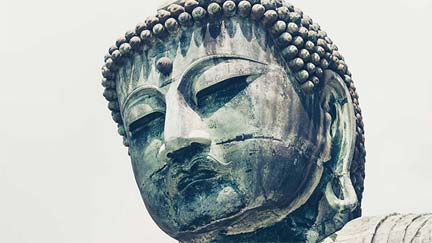
If you’re looking to take part in the heritage of an ancient kingdom, marvel at the care that goes into every detail of Japanese culture, or taste the dishes of an nation born to innovate, then visit these places in ancient Japan.
Japan's Best Festivals
Spring – Tokyo’s Sanja Matsuri During Japan’s “Golden Week,” at the Asakusa shrine in Tokyo, the wildest festival in Japan breaks out. You’ll see shirtless, tattooed Japanese men hauling around giant wooden floats (portable shrines called mikoshi) while they sing, blow whistles, and ring bells. On top of this, there is food and drink aplenty, with a massive street-party vibe everywhere.
Summer – Kyoto’s Gion Matsuri July in Kyoto is home to one of Japan’s biggest traditional festivals, Gion Matsuri. Kyoto’s downtown area is closed to traffic, turning the streets into a pedestrian mall. This is the festival to see the ancient and traditional side of Japan; people will be wearing traditional clothes, eating traditional food, and celebrating their incredible culture.
Fall – Nihonmatsu Lantern Festival Nihonmatsu is the location of one of the “big three” lantern festivals, held in early October. At night, the city is filled with beating drums and paper lanterns in all shapes and sizes lit up, as the parade marches down the street. Nihonmatsu is also reknown for it’s great sake, so make sure you try out the traditional rice-wine while you’re there.
Winter – Sapporo Snow Festival In February, the city of Sapporo turns into a winter wonderland. There are snow sculptures, sledding galore, hot food, and even a snow maze. Split between three different sites, the Odori, Susukino, and the Tsu Dome, this snowy party takes over the town. You can also travel to the top deck of the Sapporo TV tower and see the entire fest from above.

